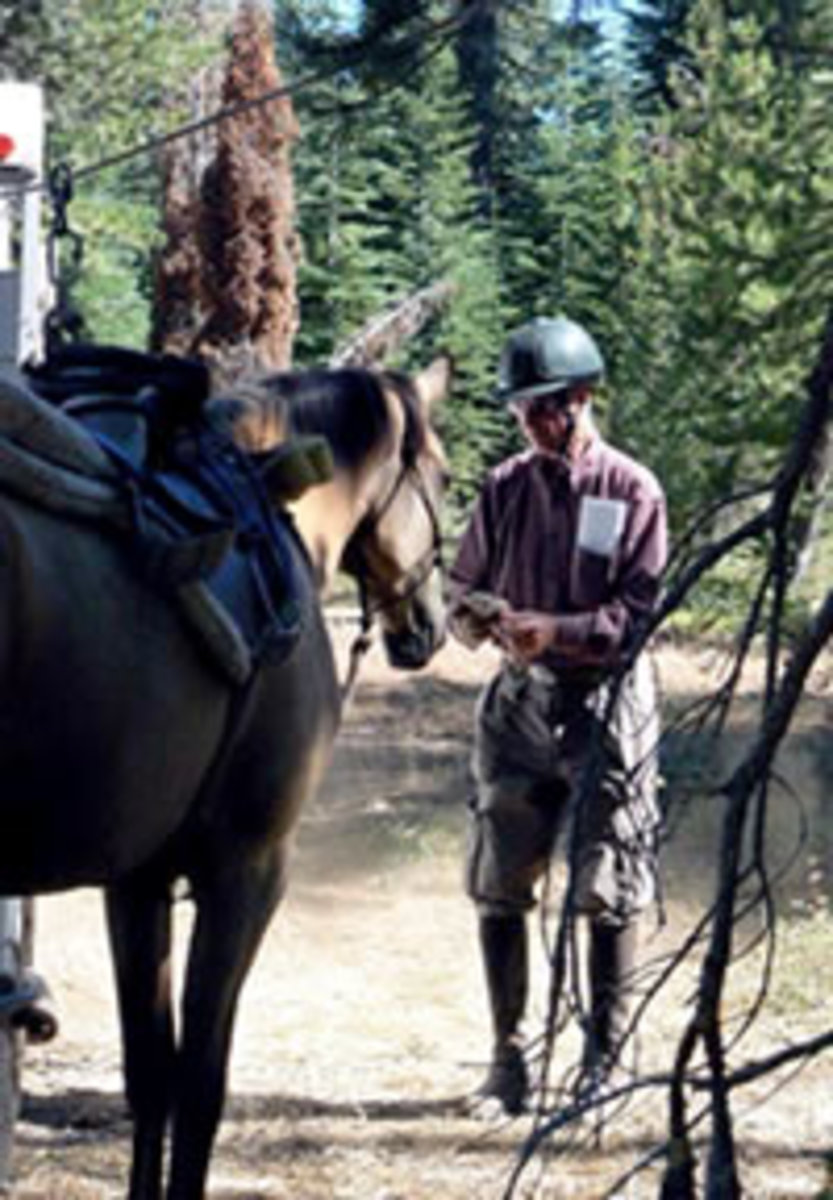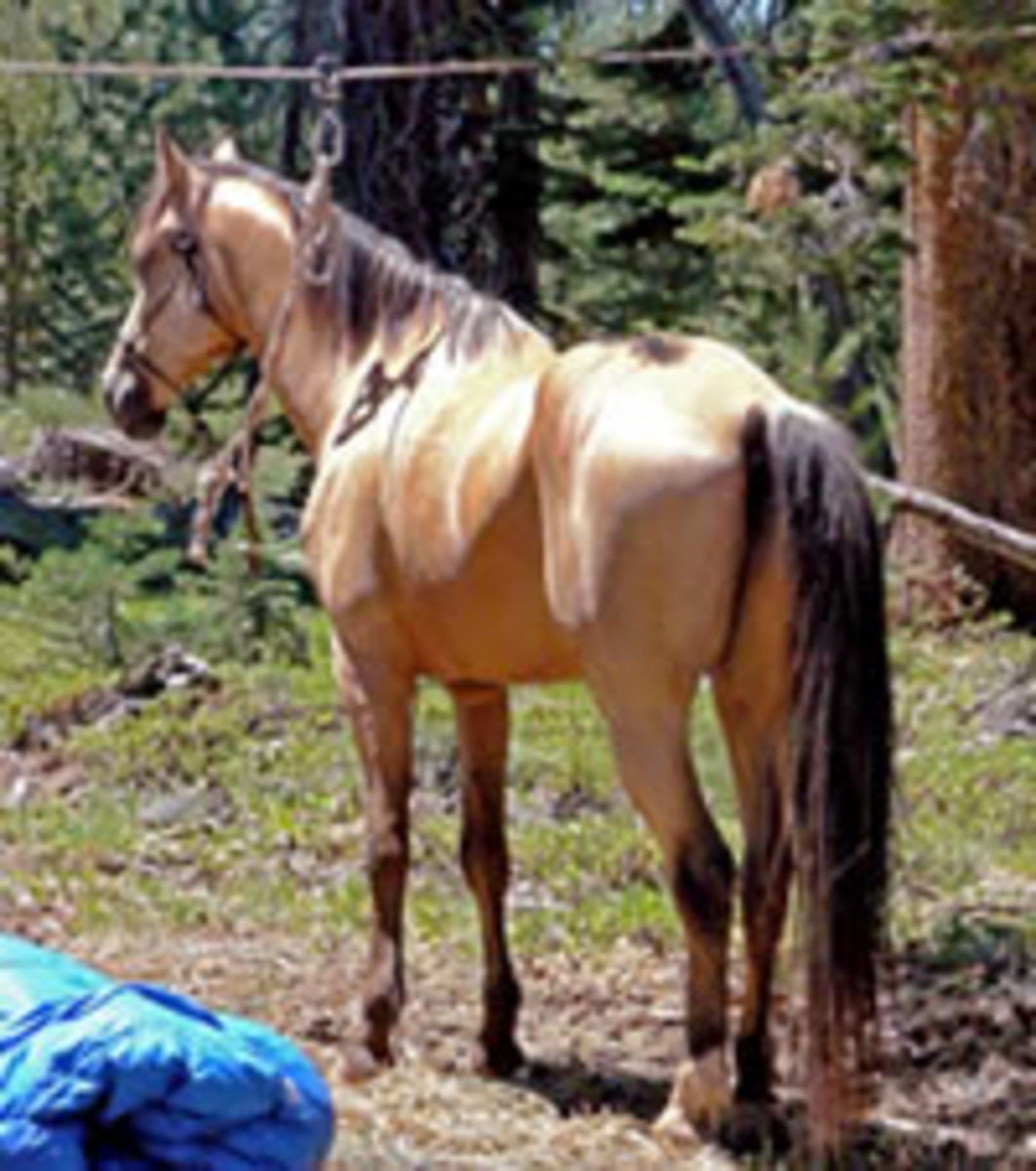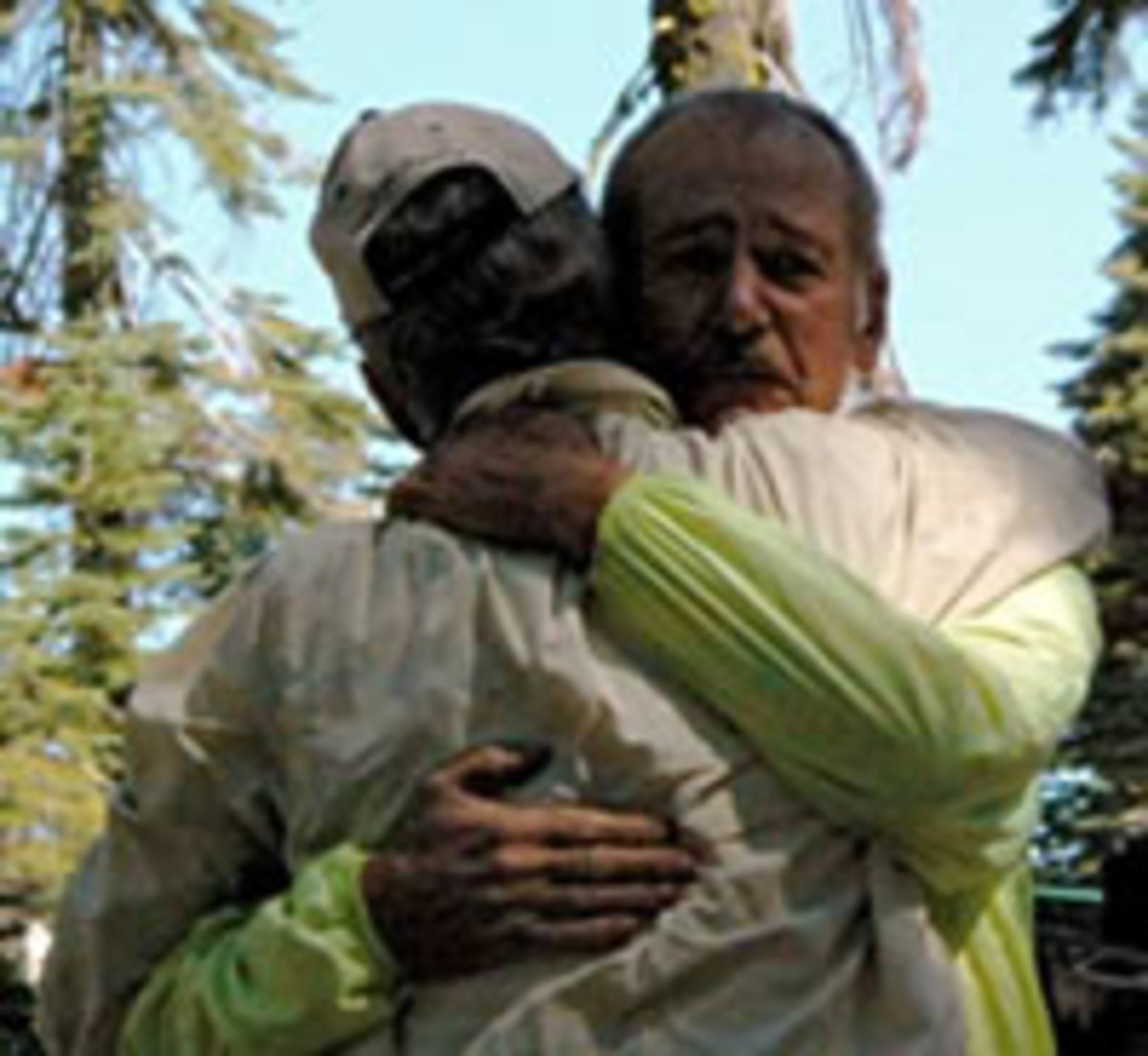A Tevis Cup Journey
- March 10, 2017
- ⎯ Bobbie Lieberman
On July 28, 2007, on the night of the full riding moon, 185 horse-and-rider teams gathered in dusty darkness, awaiting the 5:15 a.m. start of the 53rd Western States Trail Ride, also known as the Tevis Cup. Taking riders and their mounts through extremes of temperature and elevation, the Tevis is considered the most challenging endurance ride in the world.

The journey would begin under tall Truckee pines, gaining elevation steadily to High Camp near Squaw Valley, then progressing through the Granite Chief Wilderness to trace narrow trails penciled along precipices of California’s Sierra Nevada mountain range. Horses and riders would slake their thirst, cool down and refuel at checkpoints whose names bore witness to the trail’s toughness and rich history: Devil’s Thumb, Dusty Corners, Last Chance, Deadwood. Although the first finishers would take their victory lap in Auburn’s McCann Stadium before midnight, more than half the finishers would take nearly the entire 24 hours to cross the finish line and pass a final veterinary inspection to earn a silver buckle.
Among riders this year would be Matthew Mackay-Smith, DVM, 74, of White Post, Va., an avid endurance rider and EQUUS magazine’s medical editor since the magazine was founded 30 years ago. He’s a member of the endurance riding hall of fame with nearly 6,000 lifetime endurance miles and six Tevis completions. An early architect of equine sport science and an advocate of equine welfare, Mackay-Smith has earned Tevis buckles in each of four decades: the ’60s, ’70s, ’80s and ’90s. Away from the sport for six years and the Tevis for 12 years, Mackay-Smith wanted to take in the view from Cougar Rock one more time and ride through the night from Forest Hill to the finish to earn one more buckle in the ’00s.
Riding an Anglo-Arabian named Fred, Mackay-Smith made history in 1995 by becoming the first man or woman to finish first on both the Tevis and its east-coast counterpart, the Old Dominion 100 near Front Royal, Va. Many thought the feat would never be matched, but last year John Crandell, of Capon Springs, W.V., atop a powerful, elegant, blaze-faced Arabian named Heraldic, not only won both rides but earned the coveted Best Condition award.
Growing up in an endurance-riding family from West River, Md., Crandell was just eight when Mackay-Smith was winning his first Old Dominion. He considers Mackay-Smith his mentor in the sport. Crandell is now considered one of the finest endurance riders in the world, and Heraldic remains undefeated in five 100-mile endurance starts.
Two trails converged at this year’s Tevis: Mackay-Smith returning on an interior journey to see if he had one more Tevis completion in his bones, and Crandell returning as defending champion, seeking back-to-back Tevis Cups on different horses. Their mounts were superbly conditioned, both coming off wins in two tough Eastern endurance events, the Old Dominion 100 and the Michaux Madness 75. Their pacing and strategy ultimately reflected the riders’ overarching concern for the well-being of their mounts. Each eschewed a “win at all costs” mentality, opening the door to rewards perhaps richer than either had imagined.
Friday, July 27, 2007, Tevis Eve
Mackay-Smith ventured west on a personal quest–a “voyage of inquiry,” as he put it the evening before the ride. Resting on a cot under the pines as a nearly full, fat yellow moon came up, he said, “I’m in emotional territory I haven’t investigated before.” Since he finished first on both the Old Dominion 100 and the Tevis Cup in 1995, a progressive arthritic condition has bedeviled the otherwise ageless man, forcing him at 74 to flirt with the fringes of the end of his endurance career.
“As you slow down, the rest of the world seems to speed up,” Mackay-Smith observed. “If you had said to me when I was here last, ‘your next conceivable window [to ride Tevis] is gonna be 12 years from now,’ I might very well have accepted that that was a nice way of saying, ‘that’s it, buddy.'”
Although he kept up another favorite equine activity, foxhunting, Mackay-Smith often reflected on whether his endurance days were over.
“It sneaks up on you,” he noted. “Months turn into seasons and seasons turn into years. By the autumn of ’04, I was unable to ride a horse sitting still or at the walk. I could manage a trot and gallop and jump fences, but I knew I had to get that hip done.” In April 2005, he had a hip replacement.
With 10 Old Dominion buckles and six Tevis buckles, Mackay-Smith was curious to know if he could still ride a horse 100 miles in one day. He called his friend Crandell and asked him what he thought about his prospects for a comeback. “Nobody can tell you,” John replied, “you have to find out for yourself. If you want to get back in the saddle, I’ll loan you a horse, work out a program and we’ll see how far you can go.”
Mackay-Smith had been Crandell’s mentor–“He has taught me just about everything I know”–but now the tables had turned, and Mackay-Smith sought Crandell’s wisdom and guidance.
Crandell chose Rammit, an Arab/Moyle cross with a survival story that could make an EQUUS True Tale on its own. As a five-year-old, the buckskin gelding had slipped out of his pasture with several of his herdmates. Heading for home at the end of a day of freedom, he faced down a Dodge Ram pickup on a highway. When the truck didn’t stop, Rammit tried to jump it. He mashed in the grill and hood, broke the windshield and flipped over the truck. He picked himself up and trotted on home. (Thus, his name.) His face still bears tiny criss-crossing scars of that encounter, and for several months he was terrified of moving vehicles, but Rammit today is testimony to toughness and tenacity.

“He is a lot of horse, but a very curious, connected and communicative horse,” Mackay-Smith said. “He has a gossamer mouth if you are talking to him through it, and he really expects you to be paying attention 100 percent of the time. It is as if your reins are a telephone line, and he is constantly reminding you, ‘Don’t hang up!’ He may have to make a decision, and he wants you right there to guide him.”
A carefully crafted comeback began early in the spring. “Matthew was pretty wobbly the first time he got on,” Crandell recalled. “But his coordination returned really rapidly–within two or three rides his reflexes started to come alive again.” Mackay-Smith gained enough strength and coordination to finish third with Rammit on the No Frills 30 in April. After the two tied for first on the Michaux Madness 75 near Gettysburg, Pa., Mackay-Smith sent in his entry for Tevis.
So here they were, packing their crew bags and checking their saddle packs on the eve of the 53rd Tevis Cup. Mackay-Smith would ride in an old hunt saddle, well-padded with a Cloud Nine pad that his wife Winkie developed 25 years ago. His plan was to start the ride with his old friend, Roger Yohe, and his Morab gelding, Red Sans Legend. Crandell would be aboard HH Saba Shams (Sunny), a lean, leggy gray half-Arabian gelding that finished 10th on his first Tevis last year, ridden by Bob Spoor. My friend and longtime riding compatriot Barb Thomas and I were there to support everyone we could.
Saturday, July 28, 2007: The Tevis!
The Tevis Cup, a point-to-point ride from Truckee to Auburn in California is a logistical challenge for the ground crews, as trail access is limited mainly to the two one-hour holds at Robinson Flat (36 miles) and Forest Hill (69 miles). Barb and I decided to stay in Auburn the night before the ride and drive up to Robinson Flat early in the morning. Crew access is extremely limited there, but we made it in before the first horses arrived.
We watched the front runners arrive, hot and steaming from their exertions, their riders’ expressions reflecting the anxiety that goes with the territory of covering 36 miles through pointy rocks, slippery shale and hoof-sucking bogs at a fairly heady clip. As a steady stream of horses rolled into the vet check, their condition continuously improved, and their riders appeared more relaxed.
Crandell and Sunny were into Robinson around 10 a.m. and immediately pulsed down, placing them well but not threatening burnout. Sunny refueled and hydrated in a shady spot where Crandell’s wife Ann had set up a picket line between two trees. A welcome breeze wafted through the pines, delaying the onset of impending 100-degree temperatures.
Mackay-Smith hadn’t planned on going fast, but as the minutes ticked by we became a little concerned. Finally he and Rammit, still riding with Yohe and Red Sans Legend, came into Robinson Flat around 10:30 a.m. Rammit breezed through the vet check and soon was munching hay in the shade. All appeared well.
But within 10 minutes, Mackay-Smith stunned his friends when he announced his intention to withdraw from the ride right there. Yes, he could have gone on for another leg of the grueling ride, but knowing what lay ahead–the heat and canyons, the rocks and the dark–he simply didn’t feel he had the inner reserves and resources to stay the course.
His California host and riding partner Yohe was devastated. After a long hug with Mackay-Smith, Yohe and his mount soldiered on.

When he elected to call it a day on horseback, Mackay-Smith shifted gears without missing a beat, becoming a powerful and welcome ally to many riders for the rest of the day. He shifted into help mode, troubleshooting issues and offering constructive encouragement to all in need. Bob Spoor’s horse Red was slightly off at Forest Hill, but after an inspection Mackay-Smith ordered a small hole cut in the hoof’s protective pads to ease any hoof pressure. They finished in fifth place.
But the Tevis gods were not done. A few hours after Mackay-Smith bade Yohe farewell at Forest Hill, Red Sans Legend tripped in the dark. Yohe came off his horse and tumbled down a rocky hill on the infamous California Loop.
Enter Leigh Bacco, who while riding Tevis three years earlier rescued a horse who had fallen down the rocks on the same treacherous loop. In an eerie replay, Bacco, an emergency room nurse from Auburn, was riding with Yohe when he and his horse went down. As in 2004, all thoughts of the ride vanished as she called for help and tried to round up the loose horse with the help of fellow rider Jeanette Mero, DVM, riding her first Tevis on Maxymillian.
Yohe, 64, was life-flighted to a local hospital with broken ribs, a punctured lun, and liver lacerations; he is expected to make a full recovery. “Another 20 feet,” Yohe said later, “and I would have fallen off the ledge 300 feet down to the river, and they probably would have found me at Ruck-a-Chuck. I am thankful that I am alive. I was lucky, and I still have a few more Tevis rides left in me.”
Two of his “angels”, Leigh and Jeanette, ultimately finished in the top 10.
A Race to the Finish
As the dramas played out over the course and crews hurried to keep up with their charges, Crandell and Sunny continued to improve their position near the lead. By Michigan Bluff it looked like a contest between Sunny and Jayel Super. These two horses had tied for first on the Old Dominion in June. But the canyons had taken their toll on Super. Although the vets had cleared him to go on, his owner/rider Stagg Newman knew his mount wasn’t at his best. His heart rate popped up slightly during the trot-out, and the horse had muscle tremors during the steep canyon climbs. Newman didn’t want to risk further stress to his equine partner and decided to call it a day.
That left Crandell and Sunny in the lead–for a while. A group of strong horses were gaining on him, including Suzanne Ford Huff on Chase the Clouds AH and the 2004 Tevis and Haggin Cup winners, Jeremy Reynolds and CV Eli.
Sunny trotted into Forest Hill looking good, but he lost a few minutes during the pulse-taking while volunteers rechecked his heartrate. Still, he was down to 60 within four minutes and quickly moved into his mandatory one-hour hold as his rivals came into the check and took longer to recover to criteria of 64.

Leaving the check at 5:29 p.m., Sunny looked like he was on his way to an easy win, but Reynolds and Eli were determined to make a run for it. This athletic pair made up time and caught up to Crandell and Sunny just as they arrived at Francisco’s at 86 miles. Sunny pulsed down faster and left the vet check in the lead, but Eli wasn’t far behind.
“They caught up to me [again] in the [American] River, about halfway between Francisco’s and the Lower Quarry,” recounted Crandell. That’s when Reynolds and Eli jumped in front for the first time. From there it was a hand gallop across No Hands Bridge and on to the finish line.
The two rivals played cat and mouse late in the race, as Reynolds would move ahead on the trail only to be “passed” by Sunny in the vet holds with his faster recoveries. But Reynolds kept on coming, and threw down the gauntlet with a furious run for the finish, now in darkness in uncertain footing.
Reynolds had jogged the final few miles on foot the day before and seized the lead for the last time with less than a mile to go. The strategy paid off: He felt he knew the best path and could trust Eli not to stumble. Crandell, not willing to trade his chances for the Haggin Cup to go for the win, eased his horse down to a safer speed over the gnarly footing and finished about a minute behind Reynolds.
“The footing was treacherous, so I let [Reynolds] go,” Crandell said later as Sunny rested with ice boots and fresh hay. The following morning, Sunny emerged soundly to earn the prestigious Haggin Cup for the horse judged to be in superior condition.
Sunday, July 29, 2007: Epilogue
At the end of the day, Mackay-Smith had no regrets about venturing west for one more Tevis try–he’d given it his best shot and just getting to Robie Park with 185 other riders was a victory of sorts. While he can’t imagine a life unviewed from the back of a horse, he now accepts that the particular benchmark he had chosen–the world’s toughest endurance ride–had proven to be just out of reach.
While he won’t rule out future endurance events of shorter duration, Mackay-Smith is now ready to engage in other equine endeavors that “embrace my affection,” most notably continuing to educate the horse-owning public about topics that lie at the heart of good horsemanship, from identifying horses most vulnerable to that baffling scourge, laminitis, to predicting breakdowns using tiny variations in resting heart rate. His window on the west also gave rise to convictions that hard-working equine athletes need to be body-clipped and that sufficient downhill conditioning must precede an effort like Tevis that includes 22,000 feet of descent.
Endurance and education have always been Mackay-Smith’s most treasured missions, EQUUS and the back of a good horse his bully pulpits. Some things will never change. And that’s a good thing.








